Stadium revolution - who is building the most and where
source: Forbes, Sportico, China's stadium diplomacy in Africa, UEFA,; author: Miguel Ciołczyk Garcia
 Dominance of the East, stadiums on the outskirts, and a new (old) arena model. Sound enigmatic? These are changes that are taking place right in the comfort of club offices and amid the hustle and bustle on the construction sites. In the 21st century venues are part of diplomacy and key spots on the city map. Let's find out what's happening in the stadium world.
Dominance of the East, stadiums on the outskirts, and a new (old) arena model. Sound enigmatic? These are changes that are taking place right in the comfort of club offices and amid the hustle and bustle on the construction sites. In the 21st century venues are part of diplomacy and key spots on the city map. Let's find out what's happening in the stadium world.
Advertisement
1. In the centre or on the outskirts?*
The 20th and 21st centuries have been a period of strong urbanisation and urban densification. Apart from the resulting detrimental effects such as traffic jams, pollution and noise, these changes are a hard nut to crack for architects, who, when planning new stadiums or extending old ones, fight for every square metre with the ubiquitous concrete. The result? More and more sports clubs have no choice but to move to the outskirts.
Where are (and will be) the stadiums in the USA?
Megastadiums on the outskirts
In the United States, many American football teams play their matches in mega-stadiums located very far from downtown or even in other cities instead of the club's home city. A perfect example of this is Gillette Stadium, which is home to the New England Patriots (NFL) and NE Revolution (MLS) from Boston. The Razor
is located in an unurbanised area between Boston and Providence, 34 km from the centre of the first city.
A similar situation exists for AT&T Stadium, located in Arlington, where the Dallas Cowboys play. Los Angeles Rams and Los Angeles Chargers, on the other hand, come to Inglewood to play at SoFi Stadium. MetLife Stadium, despite its location in East Rutherford, hosts New York Giants and New York Jets games on weekends. The 49ers commute from San Francisco to Santa Clara to play at Levi's Stadium, and these are just a few examples. There are more; Arrowhead and State Farm Stadium, for example, are also far from downtown.
In total, as many as 10 of the 32 teams in the NFL play their games outside the city of origin. On the other hand, in the MLS it is 6 out of 29 teams. Those are:
| Stadium | Club | Located in: | Distance from the city center |
|---|---|---|---|
| DRV PNK Stadium | Inter Miami FC | Fort Lauderdale, Florida | 54 km |
| Toyota Stadium | FC Dallas | Frisco, Texas | 42 km |
| Gillette Stadium | New England Revolution | Foxborough, Massachusetts | 34 km |
| Subaru Park | Philadelphia Union | Chester, Pennsylvania | 22,5 km |
| Dignity Health Sports Park | Los Angeles Galaxy | Carson, California | 21 km |
| Red Bull Arena | New York Red Bulls | Harrison, New Jersey | 12,5 km |
Americans also build in city centres
Playing on the outskirts of cities is not the rule, however, as many teams play really close to the heart of their towns and cities. Bank of America Stadium, where Charlotte FC and the Carolina Panthers play, is only a kilometre from the centre, as are Paycor Stadium in Cincinnati or Ford Field in Detroit.
The ultra-modern U.S. Bank Stadium and Mercedes-Benz Stadium are proof that impressive billion-dollar structures are also being built in city centres. The stadiums are only 600 and 1,200 metres from downtown, respectively. Similarly, Lumen Field in Seattle is located approximately 850 metres from downtown Seattle.
Although still a lower percentage than in Europe, around 70% of teams from the NFL and 80% from MLS play in their city. So it is not as common as it may seem when looking at the major stadiums.
Where will future stadiums be located?
Miami Freedom Park Stadium, which when completed will be located 7.5 km from City Hall, is one example of bringing the team's headquarters closer to the city centre. New York FC's new venue, Willets Point Stadium, on the other hand, will be 14.5 km from downtown, exactly the same distance as Yankee Stadium. Commissioned in 2024, the new stadium for the Kansas City Current women's team was instead built 2.3 km from downtown Kansas.
New Highmark Stadium, will be erected next to the old Highmark Stadium, which is on the outskirts of Buffalo. The new Nissan Stadium, which will stand in the car park of the previous facility in downtown Nashville, similarly to the Bears' new facility as it will be built just next to Soldier Field.
Each project has different characteristics, hence many venues will be built on the outskirts, academic stadiums will be erected, as before, on campus sites, and some clubs will opt for a downtown location. However, as SoFi Stadium and Allegiant Stadium (both opening in 2020) have shown - this will be difficult for megaprojects due to the difficulty of finding enough space, among other things.

Europe does not remain in the... centre
Spanish moves
Of the major stadiums in Spain that have opened in the 21st century, only Estadio de Gran Canaria is closer to the centre than its predecessor. San Mamés Barria was built right next to the old stadium, and the Power Horse Stadium is virtually the same distance from the centre as its predecessor.
Further away from the heart of the city are instead the Cívitas Metropolitano (8 kilometres instead of Estadio Vicente Calderón's 2.3), Stage Front Stadium (9.4 kilometres instead of 3.8) or Estadio Nueva Condomina (6.5 kilometres instead of 800 metres).
Also Rayo Vallecano will probably move further away from the centre of life of the Vallecas district, in which Campo de Fútbol de Vallecas is situated. For the most part, however, when it can be done, Spaniards opt to redevelop existing facilities, hence the wave of modernisations on the Iberian Peninsula.
The example of Europe's big clubs
The situation on the Iberian peninsula is just an example that illustrates a phenomenon noticeable in many countries of the Old Continent. Bayern Munich, too, doubled its distance from the centre (from 4.5 km to 9.5 km) with its move from Olympiastadion to Allianz Arena in 2005.
Olympique Lyon, on the other hand, moved in 2016, putting the new Groupama Stadium around 11.5 km from the centre, twice the distance of its previous venue, Stade de Gerland. Lille's new stadium, Stade Pierre Mauroy, is more than 4.5km from the centre, double the distance of its predecessor, Stade Grimonprez-Jooris. Allianz Riviera in Nice was also erected on the outskirts.
The latest example of this trend is Inter and A.C Milan, who will move out of San Siro, most likely to Rozzano and San Donato Milanese respectively, both located near Milan. As a result, in all likelihood, in a few years' time Rossoneri and Nerazzurri fans will be commuting to the suburbs of Milan for their favourites' matches. Also on the outskirts, but of Belgrade, will play the Serbian national team at Nacionalni Stadion when work on the site concludes.

Greek anti-building specialists and greening of Turkish city centres
The Greeks, on the other hand, specialise in squeezing
stadiums into dense urban areas. Instead of moving to the outskirts, the Hellenic planners prefer to adapt the shape of the emerging arenas to their surroundings, so that many stadiums have an asymmetrical but ergonomic shape. This is the case with Stádio Kleánthis Vikelídis in Thessaloniki or Stádio Apostolos Nikolaidis and Stadio Georgios Kamaras, both in Athens.
A completely different approach is taken by the Turks, who often, when the need for a new facility arises, start construction on the outskirts of the city and open a park on the site of the old arena. For example, a few years after the opening of the Medaş Konya Büyükşehir Stadyumu, the old Konya Atatürk Stadyumu was demolished and a park with a water reservoir was built on its site.
Similarly, after Yeni Adana Stadyumu opened in 2021, its predecessor Historical: Adana 5 Ocak Stadyumu in Adana was demolished to make way for a garden. There are more examples, as the same scheme was applied to the construction of Yeni Eskişehir Stadyumu, Samsun 19 Mayıs Stadyumu or Kalyon Stadyumu..
And the rest of the world?
African arenas away from the cities
In Africa, many new projects are being built outside the strict confines of the metropolis. Senegal's national venue Stade Abdoulaye Wade De Diamniadio was built 30 km from the capital, in the town of Diamniadio, which was established in 2015 to relieve overcrowding in Dakar. Also in a considerable distance from the city is the Stade Nelson Mandela - about 10 km east of Algiers city centre. In the far outskirts of the Algerian capital, Stade de Douera is being built as well.
Mention can also be made of Stade Omnisport Paul Biya in Cameroon, opened in 2021, located 9 km from the centre of the capital, Yaoundé, or Stade Municipal de Kintélé, inaugurated in 2015, located 14.5 km from the centre of Brazzaville. Among the spectacular projects, Grand Stade de Casablanca should of course be mentioned. Morocco's new national stadium will be built 34 kilometres from the centre of the white city of Morocco.
Africa's third largest stadium, Borg El-Arab Stadium located in Egypt, which opened in 2006, is located 15 km from Alexandria. The second on the Dark Continent and the first in Egypt, Egypt Stadium, was built as part of the New Administrative Capital project and was erected 45 km from Cairo. Plans for a new stadium for Egypt's biggest club, Al Ahly, although not yet confirmed, also include moving out to the far suburbs.
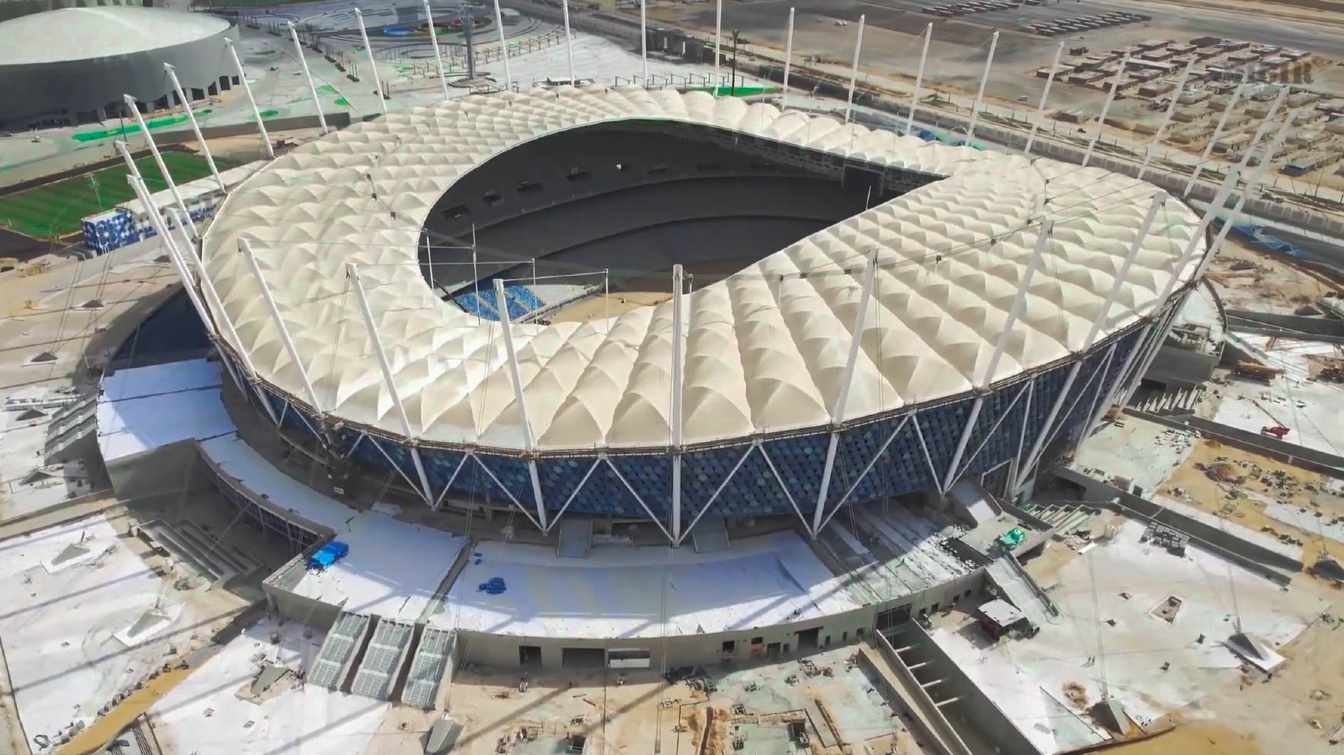 © Mahan84848 (CC BY-SA 4.0) | Egypt Stadium
© Mahan84848 (CC BY-SA 4.0) | Egypt Stadium
Asian outskirts
In Asia, too, many stadiums are going up in the suburbs. An obvious example is the Chinese venues that are being built en masse on the outskirts of cities. Recent examples include the Longxing Football Stadium or the Qingdao Youth Football Stadium opened in 2023 and located 28 and 24 km from the city centre respectively.
Nansha Cultural and Sports Complex Stadium, currently under construction, is 80 (!) km from Guangzhou city centre. Other examples include Yellow River Sports Center Stadium or Chengdu Fenghuangshan Football Stadium. Of course, this is not the case in every situation. Shenzhen Sports Center Stadium and Workers’ Stadium were built on the site of the previous venues, not far from the centre, as was the Dalian Suoyuwan Football Stadium, erected by the bay.
Laos' national venue, Laos National Stadium, opened in 2009, is located 17 km from the centre of Vientiane. Morodok Techo National Stadium, built in 2021 by China is located on the northern outskirts of Phnom Penh, 12.5 km from the centre of the capital. Many medium-sized stadiums are being built on the outskirts of cities in Iraq. Babil Stadium, Ammo Baba Stadium or Al Anbar Stadium are just some examples.
Latin America
The same trends can be seen in Latin America. Examples of stadiums located in the suburbs are Itaipava Arena Pernambuco, located 14 km from the centre of Recife, and Estadio Akron, located 12 km from the centre of Guadalajara. Estadio Nacional de El Salvador in San Salvador is also being built on the outskirts of the capital, 7 km from its centre.
Is there an alternative to moving out?
Change is inevitable. In the next decades, more and more fans will commute to the outskirts of cities for their team's matches. As a result, clubs, together with officials, will have to work out new transport plans to ensure easy access for spectators. At the expense of location and access, and sometimes even club identity, teams will be given larger and more versatile facilities.
There is, however, an alternative. Many clubs may opt for a deep redevelopment of their stadiums, or even complete demolition of the old arena to build a new one on its ruins. However, this will most often be a more expensive and complicated solution than buying land on the outskirts.
However, it is what Juventus decided to do when they built Allianz Stadium after demolishing Stadio delle Alpi. Arguably, Manchester United will behave similarly, as Old Trafford is approaching the end of its lifespan. Such an alternative may (although it will not always be profitable in the end), in addition to preserving the stadium's location, save clubs from buying new plots of land. However, as the example of Inter and A.C. Milan has shown, this will not always be possible.
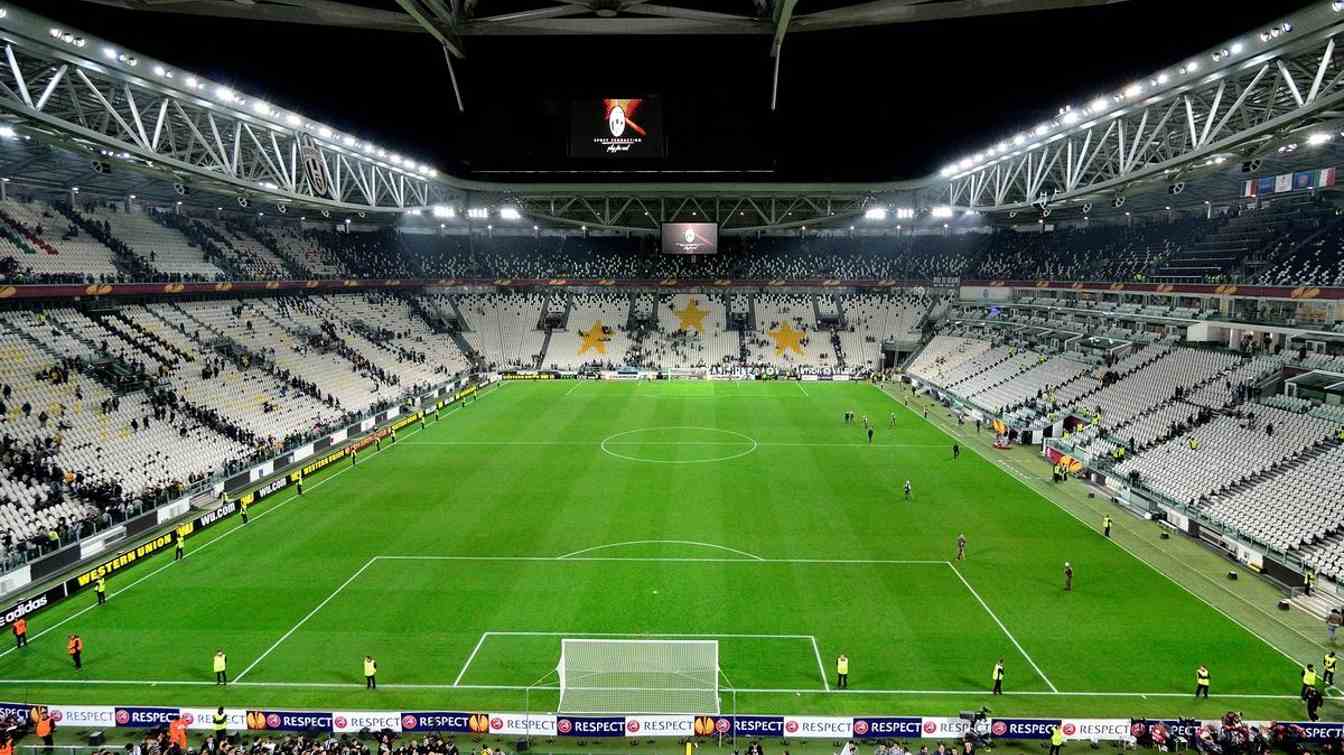 © Marco Villa | Allianz Stadium
© Marco Villa | Allianz Stadium
2. Wind from the East - who builds the most stadiums?
Although many associate impressive arenas with Europe and the USA, in recent years countries in the Middle and Far East have started to catch up with the Old and New Continents. With the rise of Saudi Arabia or China in the world of football, work on new venues has intensified. Before examining the trends, however, a fundamental question must be asked.
Why are new stadiums being built at all?
Stadiums are not at the top of the hierarchy of human needs and are not necessary to guarantee survival. However, people do have a need to gather, and to experience emotions, to participate in sporting and cultural events. Sport provides entertainment and is a break from everyday life. It also provides opportunities for competition and fulfilment.
Adequate resources (financial, material, equipment, human resources, possession of land for construction, etc.) are needed to build a stadium. Opportunities to invest in a stadium are available for large and thriving sports teams, as well as for the authorities (state and local). Often, the construction of a stadium is made possible through the support of sponsors, sometimes even through voluntary donations and collections.
For smaller players seeking investment, determination, a good business plan or the right contacts can help. A specific type of contribution enabling an investment to be made is a social act (popular especially in former communist countries).
What are the motives for building a new stadium?
The decision to build a stadium can be taken for many different reasons. There can be infrastructural reasons (the need for modernisation, an increase in capacity or a change of profile from athletics to football, for example) or organisational reasons (sporting success, the desire to improve comfort and image, the desire to increase revenues, in extreme cases a lack of agreement between the parties).
A stadium can be built for a specific purpose, e.g. for a particular football club, or for a particular sporting event. Other motives and reasons include: high ambitions, competition, social purpose, a specific idea, political programmes and promises, diplomacy or surplus resources.
Do tournaments still motivate stadium construction?
Many people remember the days when the announcement of a country to host the World Cup resulted in the mass production of stadiums. While in many cases the World Cup, Euro, Copa America and especially the Africa Cup of Nations (AFCON) can become a catalyst for the creation of arenas, such a scenario is less common these days.
In Europe and North America, the number of high-end stadiums is large enough that an upgrade or periodic capacity expansion is sufficient to host an international tournament. This is why not a single new venue will be built for the 2026 World Cup, while as many as 90% of the Euro 2024 stadiums also hosted footballers during the 2006 World Cup.
It is much more common to hear of venues being built for major tournaments in countries with poorer sports infrastructure, hence the large number of arenas built in Russia or Qatar. In Africa, stadiums are erected months before almost every edition of the Africa Cup of Nations.
Number of stadiums built for the World Cup:
| Year | Host(s) | Number of new stadiums built |
|---|---|---|
| 2006 | Germany | 5 |
| 2010 | South Africa | 5 |
| 2014 | Brazil | 7 |
| 2018 | Russia | 11 |
| 2022 | Qatar | 7 |
| 2026 | USA, Mexico, Canada | 0 |
| 2030 | Spain, Morocco, Portugal | ? |
The awakening of the East
To understand the scale of the rise of the East in the stadium world, one only needs to look at the latest edition of the Stadium of the Year competition we organise periodically. In 2023, of the 35 nominated venues, 21 were from Asia (including 14 from China), 6 from Africa (three from the AFCON host Côte d'Ivoire), 6 from Europe, 1 from the Oceania-based Solomon Islands and the one and only but victorious Brazilian Arena MRV in South America.
Mass production - Made in China
In 2022, 13 venues exceeding a capacity of 10,000 seats opened in China. A year later, it was already 15, and 10 projects (construction and modernisation) are currently underway. One impressive stadium to be built in the next few years is Guangzhou Football Park. Design: Yellow River Sports Center Stadium is also stunning in appearance.
But why does China need such an intensively developed sports infrastructure? It can be assumed that, as part of its international policy, Beijing wants to use the organisation of tournaments such as the East Asian Games to gain prestige. Moreover, China hosts a plethora of regional sports tournaments, which partly explains the rationale for the projects.
Although The Middle Kingdom has not currently applied to host the World Cup, it is highly likely that it will do so in the next decades. Such political and infrastructural power will be hard to deny then.
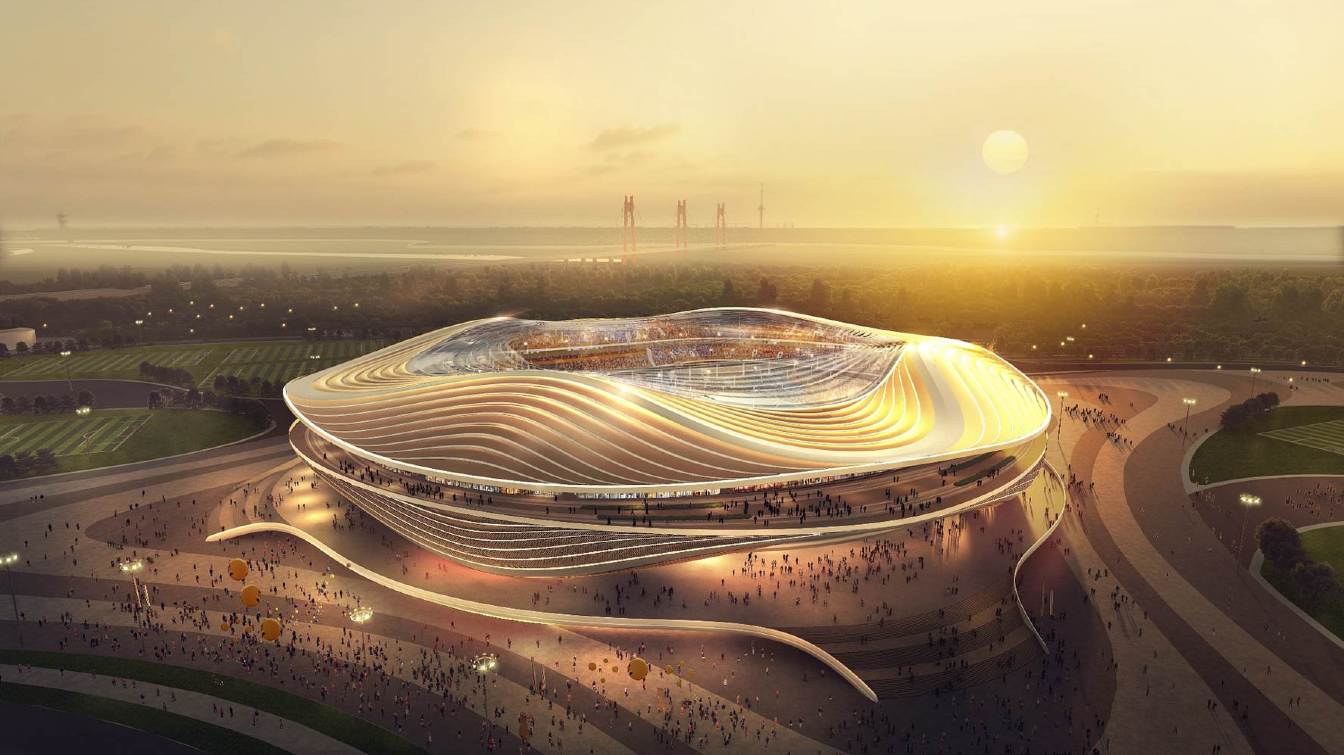 © HPP, BIAD | Design of Yellow River Sports Centre Stadium
© HPP, BIAD | Design of Yellow River Sports Centre Stadium
Another boom in the Middle East?
The 2022 World Cup may not be the last stadium boom in Middle Eastern countries. Of course, projects are being built in smaller numbers and without as much controversy, but the region continues to grow in football, as shown by the big names in the Saudi Professional League.
In Arabia, the redevelopment of Al Ettifaq Club Stadium, Al Fateh SC Stadium and Al-Shabab Club Stadium was completed in 2023, with the first matches played at Kingdom Arena in January 2024.3 more venues are under construction in Iraq and several projects are still pending. In recent years, Iraq has built Al-Madina Stadium, Al-Minaa Olympic Stadium and Al-Zawraa Stadium. In Israel, on the other hand, Ashdod Stadium is currently under construction.
A major driving force for the stadiums under construction and pending projects in Saudi Arabia will be the 2034 World Cup, as it is virtually confirmed that it will be played in this country.
Rest of Asia and Oceania
Apart from the Chinese venues, in Asia, the impressive Kai Tak Sports Park Main Stadium in Hong Kong, AFC Stadium in Malaysia and both Kanazawa Stadium and PEACE STADIUM in Japan are also currently under construction. On the other hand, in Oceania only Te Kaha of New Zealand is being built.

What about America and Europe?
Stadium stagnation in Europe?
It is no secret that as many venues are no longer being built on The Old Continent as they used to be. As the examples of the Estadio Santiago Bernabéu, Camp Nou, Anfield or Etihad Stadium show, most clubs are now focusing on modernisations. This is because most stadiums in Europe are relatively new, so upgrades are usually enough to keep facilities in satisfactory condition.
Of course, there are exceptions, as with the construction of Everton Stadium or the likely abandonment of Old Trafford due to wear and tear of a stadium that is more than 110 years old. The same is true in the case of San Siro, inaugurated in 1926. In most cases, however, it is more optimal to renovate and, in the case of hosting the World Cup or Euros, to adapt the venue by periodically increasing the number of seats.
Calm before the storm in the USA
There is a greater prospect of more stadiums being built in the USA, where stadiums are considered obsolete much more quickly. Apart from Soldier Field, which was built in 1924 (but after the 2003 renovation only the outer walls remained of the original structure), and Lambeau Field, which opened in 1957, no NFL arena is over 60 years old.
Much of the NFL construction took place in the 1990s and the first decade of the 20th century. Because of this, fewer arenas are currently being built, but in a few years or so, a so-called echo boom can be expected, when many stadiums built during a similar period will be declared obsolete, resulting in a wave of new construction and deep upgrades.
Despite the apparent quiet, there is intense work going on in the offices. Mike Ondrejko, head of Legends Global Sales said: This is the most active period I have ever seen.
New stadiums for the Tennessee Titans and Buffalo Bulls are currently on the horizon: new Nissan Stadium and New Highmark Stadium, as well as a new venue for Chicago Bears and Chicago fire that will replace Soldier Field.
A more active league recently has been the MLS, which has opened five arenas between 2021 and 2022. The vast majority of Major Soccer League venues were built in the 21st century, hence no spectacular boom should be expected here in the next few years, unlike in the NFL. Miami Freedom Park Stadium is currently in the phase of preparing for construction, and work on Willets Point Stadium should start soon.

African (?) constructions
Of the arenas under construction, the vast majority are being built by Chinese corporations as part of Beijing's stadium diplomacy (more about this further on). A significant number of these are being built in the Dark Continent on the occasion of tournaments, most notably the Africa Cup of Nations. It is not uncommon for facilities to remain unused after the tournament has been played.
Côte d'Ivoire is an example of this. While one venue was inaugurated there in 2022, Stade Amadou Gon Coulibaly and Stade Laurent Pokou (Chinese projects) were opened in 2023 and the redevelopment of Stade de la paix de Bouaké was completed. All of them, of course, before the 2024 AFCON was played precisely in the JCS, whose national team won the tournament.
It is not just the Africa Cup of Nations, however, that is catalysing the creation of stadiums in Africa. One country that has been steadily opening new venues in recent years is Egypt, which hosted the 2019 AFCON but opened the Suez Canal Authority Stadium already after the tournament, while it recently built the impressive Egypt Stadium and is still erecting the Al Masry SC Stadium. Two major venues have been built in Algeria - Stade de Douera and Stade de Tizi-Ouzou.
3. Stadium diplomacy of the Middle Kingdom
Sporting elements of foreign policy
Economy, armed forces and... stadiums. These seemingly unrelated issues are important elements of China's geopolitical jigsaw puzzle as it seeks to shake up the world order by investing not only in the military or business. A relevant element of Beijing's foreign policy is the construction of sports facilities.
While the United States maintains influence in Europe or Oceania, the People's Republic of China seeks allies primarily among the countries of the so-called Global South. One way of gaining support in developing countries is precisely to finance the construction of new facilities, hence the term stadium diplomacy.
Dominance in Africa
Initially, stadium diplomacy was limited to neighbouring countries, as exemplified by the assistance provided to Mongolia for the construction of National Sports Stadium in 1958. Similar projects were also carried out in Indonesia or Cambodia in the 1950s and 1960s.
As China's importance grew, its horizons also broadened. In return for establishing diplomatic ties with Communist China, outsourcing work to Chinese companies and severing relations with Taiwan, The Middle Kingdom began to finance more and more construction and modernisation on The Dark Continent.
The first project was the modest Amaan Stadium, inaugurated in 1970, but others followed, bigger and more expensive. In at least half of African countries, arenas have been built for which funds flowed from Beijing. In total, this amounts to a minimum of 90 stadiums.
The image and economic gain was and is enormous. In addition to prestige and a debt of gratitude among underdeveloped countries, China gained preferential trade deals and favourable interest rates on the loans that governments took out to build the stadiums. Parallel to the construction of arenas, the Chinese financed the construction of government buildings, hospitals or presidential palaces.
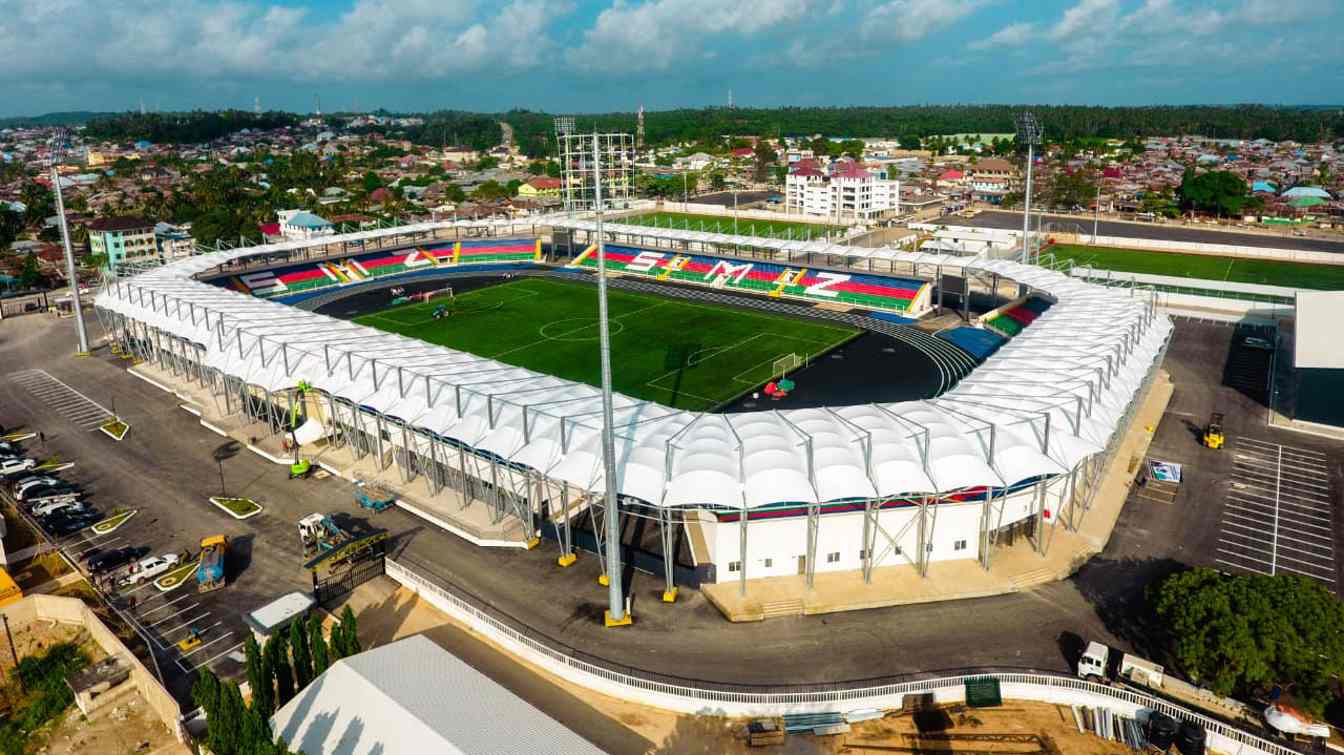 © Diramakini | Amaan Stadium
© Diramakini | Amaan Stadium
The Global South plays on Chinese stadiums
However, China did not limit itself to dominance in Africa and Asia. According to Mieszko Rajkiewicz's study of China's Stadium Diplomacy in Africa, the country has built more than 140 (!) stadiums in over 60 countries around the world, covering Latin America or the Pacific in addition to the continents mentioned above, with the total cost of the investments already running into billions of dollars.
Recent examples of facilities built by Chinese designers include Estadio Nacional de Costa Rica (2010),Morodok Techo National Stadium in Cambodia (2017), Bingu National Stadium in Malawi (2017), or Stade National de la Côte d’Ivoire (2020) and Stade Laurent Pokou (2023) in Côte d'Ivoire. There will be more projects, although they are not always top-class.
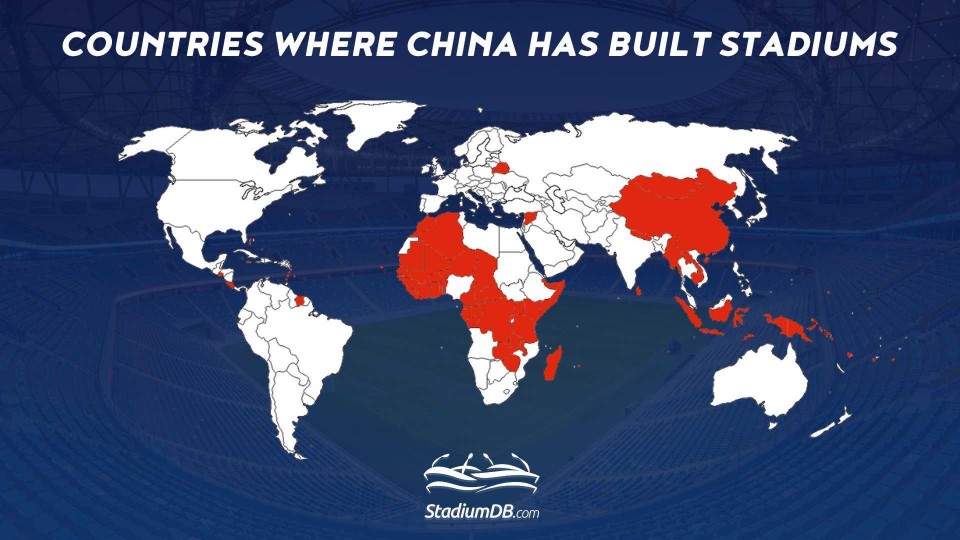
What does Chinese quality mean?
The local population knows when a stadium is built by the Chinese, which builds the image of Beijing as an ally of the Global South. It is definitely more profitable for politicians to use aid from the Middle Kingdom than from the so-called West, because China, unlike the USA and Europe, does not condition economic aid on the introduction of a democratic system, fight against corruption or respecting human rights.
However, things are not always rosy. Very often, stadiums built on the outskirts of cities lack transport infrastructure and, once the Chinese withdraw, maintenance problems arise. Taking Africa under the scope, projects are often created with the Africa Cup of Nations in mind, and once the month-long event is over, attendance never again approaches the stadium's maximum capacity. Such was the case with Stade d'Oyem, which was quickly abandoned after hosting a few matches in the 2017 AFCON group stage.
Many stadiums are built based on the same designs, and although in recent years there has been more attention to detail (such as seats in the country's colours), for many people they are soulless concrete molochs with a shabby finish. However, this does not change the fact that politicians are enthusiastic about the new arenas and China has no competition in the construction market in the developing countries, even though Turkey and France, among others, are also vying for influence in these regions of the world.
New (old) stadium model gains popularity
It's a well-known fact that stadium maintenance is a costly endeavour. And if this is the case, how to reduce the costs associated with arena operation? How to make the facilities profitable and not just a burden? The Americans found the answer to this question, and the model they implemented is today gaining a new face in Europe (and beyond).
An American invention
How did a multi-purpose stadium come about?
In the 1960s and 1970s, in an attempt to optimise expenditure, clubs popularised the concept of multi-purpose stadium. The premise was simple - the facility had to be suitable for a minimum of two sports. The most common combinations were American football and baseball, American football and association football (soccer). In addition to this, arenas were often equipped with an Olympic treadmill.
The predecessor of the current multi-purpose Yankee Stadium, which bore the same name, where the New York Yankees baseball and NY Giants football teams played their games, is considered to be the first multi-purpose stadium. Many more similar venues were built, however, and some are still in use today. These include Oakland Coliseum, Robert F. Kennedy Memorial Stadium and the famous Hard Rock Stadium.
The joint venture between two teams allowed for a significant reduction in costs, especially if the local authorities could be persuaded to finance part of the investment presented as a joint future for the city's teams. However, it quickly became apparent that multi-purpose stadiums had irresolvable drawbacks.
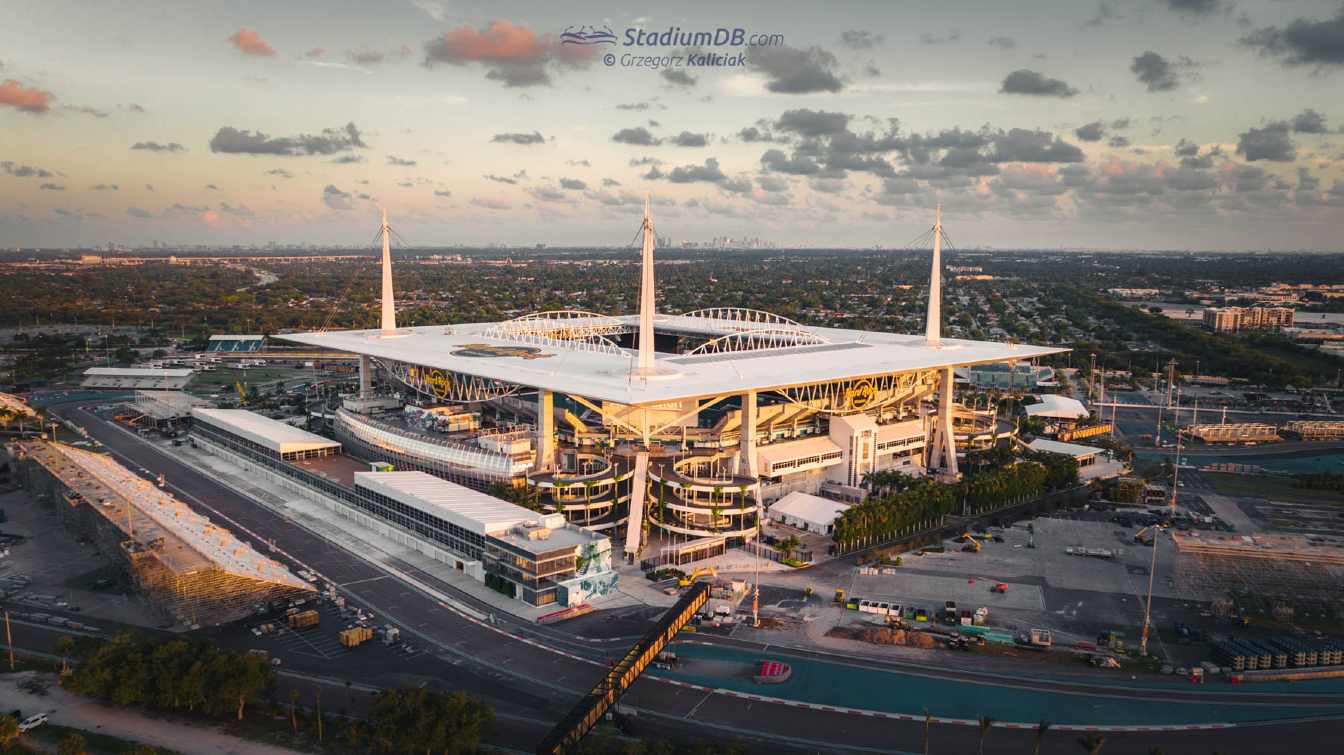 © Grzegorz Kaliciak | Hard Rock Stadium
© Grzegorz Kaliciak | Hard Rock Stadium
The downfall of multi-purpose stadiums
The biggest problem was the stands. In order to avoid erecting columns that would obstruct the playing field, the facilities were low and the upper stands were pushed back. This led to visibility from the top sectors being very limited. In addition, baseball games almost never filled these stands. The lowest sectors, on the other hand, were too low to comfortably watch football games.
The arenas erected in this way earned the nicknames cookie cutters
and concrete donuts
because of their appearance. The indentation of the stands used for the baseball playing field was also a problem, because during American football or football games even the lowest row of stands was far from the playing field. The same problem was caused by the Olympic treadmills. As a result, multi-purpose stadiums started to become a thing of the past.

A miraculous revival?
However, if one were to check the venues on which US NFL and MLS teams play, one would find that many teams share a stadium. This is the case for Bank of America Stadium, Mercedes-Benz Stadium, Lumen Field, Soldier Field, or Gillette Stadium. The similar dimensions (105x68m in football and 110 x 49m in American football) and the shape of the turf in both sports favour such initiatives.
But there is another, more modern aspect that distinguishes multi-purpose stadiums. Today, the term multi-purpose stadium
can be understood to mean not just an arena for multiple sports, but the centre of city life. Twentieth-century multi-purpose venues host concerts in addition to matches, and have shopping centres, restaurants, conference halls or even hotels inside.
There are a number of stadiums that operate in this way, aspiring to be a 365/7 stadium - a venue that is open all year round and attracts not just on match days, but all the time thanks to its extensive commercial and entertainment offerings. The Dallas Cowboys, the club with the highest revenue in the NFL, owes more than half of its profits to its facility:
| Club | Venue | Stadium revenue (2018) | Total revenue (2018) |
|---|---|---|---|
| Dallas Cowboys | AT&T Stadium | $621m | $950m |
| New England Patriots | Gillette Stadium | $315m | $600m |
| New York Giants | MetLife Stadium | $262m | $519m |
Europe is copying from the Americans
The American Dream in England and Spain
In Europe, a classic
multi-purpose venue is Wembley Stadium. When it comes to the 24/7/365 stadium concept, the Premier League is probably the strongest league. Mention must be made of Tottenham Hotspur Stadium for its fan experience (fan attractions), Arsenal's Emirates Stadium for its matchday experience and the emerging Everton Stadium.
The most spectacular example of the implemented 7/365 multi-purpose stadium concept in Europe, however, is the new Estadio Santiago Bernabéu. Florentino Pérez's gem is not only expected to host Los Blancos, but also concerts by major stars and occasionally even an NFL match. The new version of the royals' venue is expected to provide up to €400 million in revenue through shops, restaurants, an e-sports zone or an enlarged museum. There is even room for a... brewery.
Of course, Real Madrid is not the only Spanish giant looking to make money from its facility. FC Barcelona also intends to make as much money as possible with Nou Camp Nou. The Espai Barca project is expected to generate ⅔ of the club's revenue - up to €347 million a year. Other smaller clubs on the Iberian peninsula are also looking to make their non-matchday offerings more attractive.
Which stadiums generate the most revenue?
UEFA's report The European Club Finance and Investment Landscape shows that FC Barcelona and PSG earned the most from ticket sales in 2023, but among the 10 clubs making the most profit from ticket sales are as many as five Premier League teams. Those are:
| Pos. | Club | Stadium | Ticket revenue in 2023 (in €m) | Revenue per match (in €m) |
|---|---|---|---|---|
| 1. | FC Barcelona | Spotify Camp Nou | 190 | 7,6 |
| 2. | PSG | Parc des Princes | 153 | 6,6 |
| 3. | Tottenham | Tottenham Hotspur Stadium | 135 | 5,6 |
| 4. | Real Madrid | Estadio Santiago Bernabéu | 134 | 4,8 |
| 5. | Manchester United | Old Trafford | 128 | 3,8 |
| 6. | Bayern München | Allianz Arena | 121 | 5,2 |
| 7. | Arsenal Londyn | Emirates Stadium | 118 | 4,9 |
| 8. | Liverpool | Anfield | 92 | 3,7 |
| 9. | Manchester City | Etihad Stadium | 84 | 2,5 |
| 10. | AC Milan | Stadio Giuseppe Meazza | 79 | 3,0 |
This summary only takes into account revenue from ticket sales, but it provides some guidance for looking for venues that are managed in the most profitable way. Attention is drawn, for example, to PSG, which, despite having much lower (in absolute numbers) attendances than most of the clubs on the list, makes proportionately huge profits on match days thanks to its extensive VIP offer.
Another clue as to where to look for the best model for the operation of venues comes further down the UEFA report. According to the European federation, the Premier League earned €894m on match days in 2022, twice as much as second-placed La Liga, whose clubs pocketed €432m from ticket sales. France is next (€355m) followed by Germany (€301m) and Italy (€218m).
Impressive stadiums in Asia, Africa and South America
Outside the United States and parts of Europe, the 7/365 stadium concept is not yet widely used due to, among other things, a lack of resources, the lower popularity of association football or American football and technological inadequacies.
However, it is possible to appreciate gems
that impress with their grandeur and functionality. The Asian Kai Tak Sports Park Main Stadium in Hong Kong or the Hangzhou Sports Park Stadium with its surrounding complex are such facilities, as is Singapore National Stadium within the Singapore Sports Hub.
Among the venues worthy of inclusion to the prestigious group of multipurpose 7/365 arenas in Latin America are Allianz Parque, Arena do Grêmio or Estadio BBVA. The African venues, new Stade Amahoro in Rwanda or Egypt's new national stadium should also be mentioned.
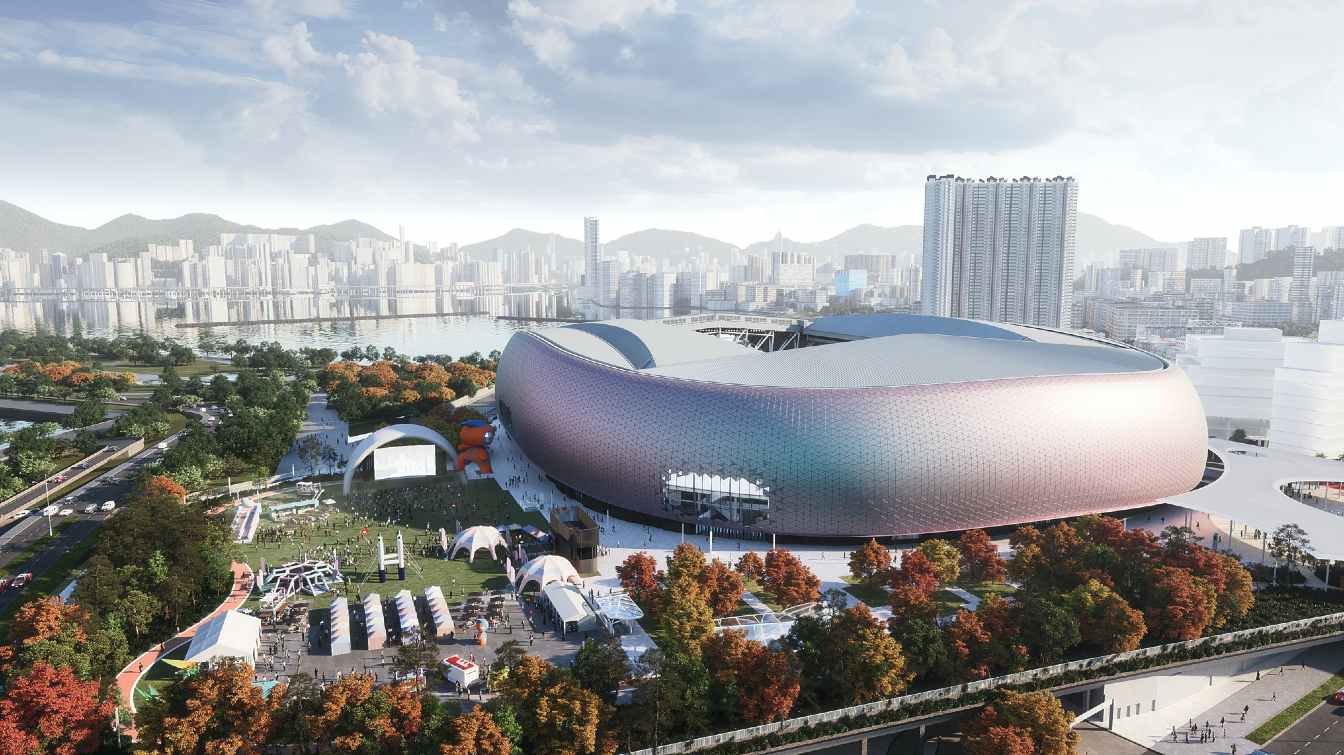 © Kai Tak Sports Park | Design of Kai Tak Sports Park Main Stadium
© Kai Tak Sports Park | Design of Kai Tak Sports Park Main Stadium
Stadiums of the future
While the differences around the world in the sophistication of sports infrastructure are gigantic (from the 'concrete molochs' built by China in Africa to the ultra-modern stadiums in the USA and Europe), it is noticeable that more and more countries are betting on impressive stadium projects, open for the public 7/365 and geared towards creating a new commercial, sports and cultural hub for the city.
Matches, concerts, tournaments, shops, restaurants, museums and even hotels or, as in the case of Tottenham, a karting track (!) are supposed to attract fans (and customers) to arenas that are open all year round and allow them to make money for themselves. Projects like the ones mentioned above will therefore increase in number, because although they raise the cost of the project, the chances of return on investment and long-term profits also increase exponentially.
A spectacular stadium project within the sports city of Qiddiya in Saudi Arabia was presented by Populous. We also learned of an incredible vision for a new arena in New Zealand, as well as a more modest but still fabulous visualisation of FC Sion's new venue in Switzerland.
The list of the next in line include AC Milan, Inter or Roma, and potentially Chelsea, PSG and Manchester United. For the 2030 World Cup in Morocco, an impressive design of the Grand Stade de Casablanca will be implemented. Not all the spectacular visions will be acccomplished, of course, but these projects are a foretaste of the arenas from whose stands we will be cheering on our favourites in a few decades' time.
*all measurements shown are the straight line distance from the stadium to the town hall
Advertisement

 StadiumDB
StadiumDB